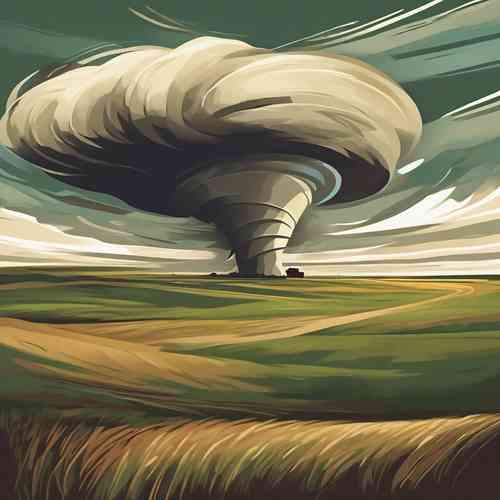- Published on
Canada's Roaring Skies: Unpacking the Adrenaline and Reality of Prairie Tornado Season
- Authors

- Name
- Juno Ryelie

Canada's Roaring Skies: Unpacking the Adrenaline and Reality of Prairie Tornado Season
As the Canadian Prairies brace for another active tornado season, storm chasers and experts alike are observing a potent mix of atmospheric conditions fueling severe weather. From the sheer adrenaline of witnessing a funnel cloud touch down to the sobering reality of destructive paths, understanding these powerful natural phenomena is crucial for residents in vulnerable regions.
Quick Context
The recent weeks have seen a flurry of severe thunderstorm activity capable of producing tornadoes across the Canadian Prairies and neighboring U.S. states. This surge in extreme weather events highlights the ongoing challenges and risks faced by communities.
Surprising Fact: The Chase for Adrenaline
For individuals like Ethan Caners, a physical geography student and storm chaser, witnessing a tornado reach the ground is described as "pure adrenaline." Caners recounts being on the ground when a tornado ripped through Cass County, North Dakota, documenting its entire genesis and transition.
Key Incidents: A String of Twisters
In just the past two weeks, twisters have touched down in Saskatchewan, North Dakota, and Minnesota. Notably, three people were killed and at least 10 homes were destroyed in the destructive path of a tornado in Cass County, North Dakota. Another struck Hartland, Minnesota, and eight confirmed tornadoes touched down in Saskatchewan on June 19.
What You Need to Know
Canada, particularly its central provinces, experiences regular tornado activity, a fact often overshadowed by the more widely known "Tornado Alley" in the United States. However, experts confirm that the conditions for severe twisters are frequently present north of the border.
Geographic Reality: Canada's Northern Tornado Alley
Manitoba, in particular, lies on the northern tip of Tornado Alley, making it susceptible to powerful storms. While Manitoba hasn't seen as many tornado developments in the last couple of weeks, two weak ones were confirmed in the province back in May. The province typically experiences anywhere between ten to a dozen tornadoes in an average year.
Frequency & Severity: Understanding the Risks
While average years see a consistent number of tornadoes, catastrophic events, though rare, are not unprecedented. The infamous F5 tornado that devastated Elie, Manitoba, in 2007 serves as a stark reminder of the potential for extreme devastation. EF5s are globally uncommon, even in the U.S., making their occurrence in Canada particularly fortunate for their rarity.
Safety Protocols: When a Warning Strikes
Both experts and storm chasers emphasize the critical importance of vigilance when severe storms roll through and a tornado alert is issued. Immediate action is paramount: listen to warnings, take cover, and seek shelter. The safest place is a basement; if unavailable, staying away from windows, doors, and exterior walls is crucial. Outdoors, finding a low area and shielding one's head can offer some protection.
Why This Matters (Implications)
The increasing frequency and intensity of severe weather events, including tornadoes, have profound implications for communities, emergency services, and infrastructure. Beyond the immediate threat to life and property, there are broader societal and economic impacts to consider.
The human cost, as evidenced by the fatalities and destruction in recent U.S. twisters, underscores the vulnerability of populated areas. For Canadian provinces like Manitoba and Saskatchewan, understanding and preparing for these events is not just a meteorological curiosity but a fundamental aspect of public safety and disaster preparedness. The psychological toll on affected communities, coupled with the immense financial burden of recovery and rebuilding, highlights the far-reaching consequences of an active tornado season.
What Experts Are Saying
Meteorologists and those who intimately interact with these powerful storms provide crucial insights into their formation and behavior, helping us understand the current trend composition.
Expert Perspective 1 (Ethan Caners, Storm Chaser)
Ethan Caners, who witnessed the Cass County tornado, describes the experience vividly: "When you’re watching that tornado reach from the sky and touch the ground, it’s just pure adrenaline. It’s everything you can think of when you see a cloud touch your ground." His account underscores the awe-inspiring yet terrifying power of these storms.
Expert Perspective 2 (John Hanesiak, Atmospheric Science Professor)
John Hanesiak, an atmospheric science professor at the University of Manitoba, notes the consistent atmospheric conditions contributing to the recent activity. "We’ve sort of been in this pattern where all the ingredients are in place for such types of storms," he states, indicating that more tornadoes are likely to form this summer in Manitoba. He also stresses the extreme rarity of EF5 tornadoes, offering a degree of reassurance while still urging vigilance.
Potential Impact & Future Outlook
Given the current atmospheric patterns, the outlook for the Canadian Prairies points towards a continued heightened risk of severe weather. The "ingredients" for powerful storms seem to be consistently in place, suggesting that residents should anticipate a dynamic and potentially challenging summer.
In the short term, this means an increased need for immediate vigilance, robust early warning systems, and public education on safety protocols. Communities will need to be prepared for rapid response to severe thunderstorm and tornado warnings. Long-term, the trend could necessitate more resilient infrastructure, updated building codes, and potentially shifts in land-use planning in high-risk areas. While the rare EF5 tornadoes remain an outlier, the consistent threat of weaker yet still destructive twisters demands ongoing attention and adaptation from all levels of society.
As tornado season progresses across the Prairies, the blend of exhilarating observation for storm chasers and urgent warnings for residents paints a vivid picture of nature's raw power. Staying informed and prepared is the best defense against these formidable forces. Share your thoughts on extreme weather preparedness in your community, and stay updated with the latest meteorological alerts.
Categories: Technology & Science